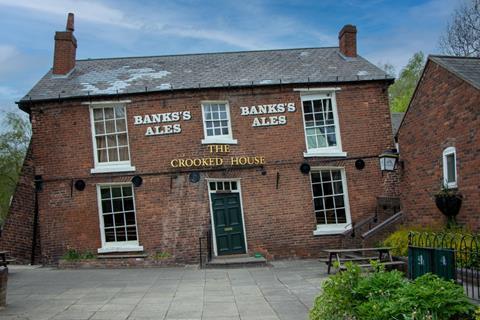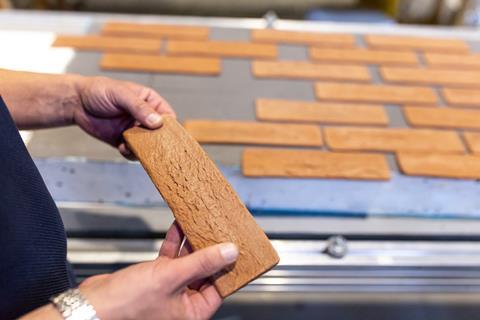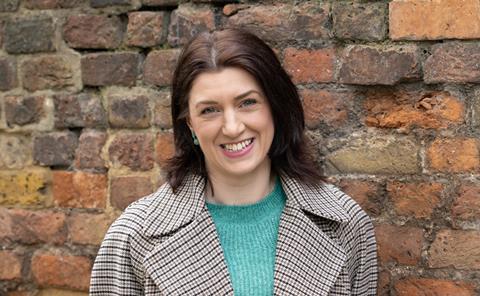South Staffordshire Council has ordered the owners of BritainÔÇÖs wonkiest pub to recreate it as it was before its unlawful demolition. Donald Insall Associates and Purcell explain how they would approach what has become one of the countryÔÇÖs most unlikely - and high profile - restoration projects

Has there ever been a construction project quite like this? Last week, South Staffordshire Council ordered The Crooked House pub, in the village of Himley near Dudley in the Black Country, to be . It was a standard issue enforcement notice, giving the owners three years to complete the job.
But this is no normal building. It was ÔÇťBritainÔÇÖs wonkiest pubÔÇŁ. It was severely deformed, leaning at a 15 degree angle after nearly two centuries of subsidence. And it is now a pile of bricks.
It takes one look at a picture of what the beloved two-storey pub used to look like before it was destroyed ÔÇô first gutted by fire and then flattened without authorisation ÔÇô to see the challenge of accurately recreating it. It contains barely a single straight line or regular shape, being built entirely out of materials which have all become warped in their own unique ways over centuries.
But, after the national furore which erupted last summer over its destruction, this is now one of the highest profile restoration projects in the country. It is also one of the most bizarrely British stories in recent years.
> Also read:
> Also read:
Across the Channel, master craftsmen are using traditional techniques to rebuild Notre Dame following the fire which damaged the gothic masterpiece in 2019. Over here, we could be asking people with the same level of skill to rebuild a wonky pub destroyed in a suspected arson attack.
ÔÇťItÔÇÖs a story for modern Britain,ÔÇŁ says Matthew Vaughan, practice director at Donald Insall Associates. Achieving an authentic reconstruction would be like ÔÇťfinding the greatest painting conservators in the world to apply the skill that they would normally put on repairing a tear in a Van Gogh and applying it to a painting which nobody thought was of a particularly high standard anyway,ÔÇŁ he says.
It will also probably cost around three to five times as much as building a normal pub of that size, according to Vaughan. ÔÇťIt is crazy.ÔÇŁ Will Donald Insall Associates be bidding for it? ÔÇťOh, 100%.ÔÇŁ
ÔÇťWeÔÇÖll be at the front of the queue if it comes out to tender,ÔÇŁ Vaughan confirms. ÔÇťBut itÔÇÖs going to use everybodyÔÇÖs ingenuity, all the ingenuity out there to do this thing. YouÔÇÖve got to be going in there knowing itÔÇÖs going to be a real challenge.ÔÇŁ

So how do you actually go about rebuilding the pub in a fashion that is sufficiently wonky to satisfy the local council? Originally built as a millhouse in 1765, it only started sinking on one side in the mid-19th century, probably due to mining activities in the area. It has seen many attempts to halt its embarrassing slide over the years, from a large buttress built in 1904 to steel reinforcements added in the 1950s.
These measures have prevented a full collapse, although to the delight of locals and tourists it has maintained its tilt, becoming famed for making bottles appear to roll uphill along the bar and making even teetotallers feel drunk.
Many buildings have been built over the centuries that are not square, either by design or not
ÔÇťTechnically, it will be entirely possible to rebuild it in this way,ÔÇŁ says Liz Smith, chair and regional partner at Purcell, which is likely to be one of Donald Insall AssociatesÔÇÖ main rivals for the job. ÔÇťMany buildings have been built over the centuries that are not square, either by design or not.ÔÇŁ
The question is whether the selected team reassembles the building as it was brick by brick or creates what would essentially be an ersatz version using modern techniques. Aiding the former option is the pile of rubble on the site, which contains much of the buildingÔÇÖs original structural fabric.
With the salvaged bricks there will need to be a careful process of reviewing their potential for reuse, both for restoration authenticity and sustainability reasons, Smith says. ÔÇťIt is likely that much of what was rescued will be reusable, or at least used to inform the process and details of reconstruction.ÔÇŁ
Complicating this would be the unique shapes of the bricks, which had formed into wavy lines over the years as the building slowly collapsed like a badly cooked meringue. The surviving material does open the option of recreating the walls at least partially, according to Vaughan, either with full nine-inch thick walls or four-and-a-half inches, attached at a slanted angle to a steel frame with an internal lining to make up the original thickness.
The problem with this approach, he admits, is that it would effectively be like trying to ÔÇťbuild a Zaha Hadid building with traditional materialsÔÇŁ.
The alternative would be recreating the entire building with a slanting concrete shell and steel frame and then facing it with brick slips, thin decorative tiles which have the surface appearance of real bricks. This would likely be the easiest option from a construction point of view, although the slips have a habit of dropping off and the building could end up looking ÔÇťa bit cheap,ÔÇŁ according to Vaughan.
ÔÇťIt would be such a messÔÇŽ It needs to be something a bit more enduring if itÔÇÖs going to have any kind of sense of authenticity, I think.ÔÇŁ

Other parts of the structure, including its entirely irregular window frames, would need to be reconstructed from scratch using new materials. This is where inaccuracies are most likely to creep in, as the more perishable parts of the pub have clearly been replaced in an ad hoc fashion over time by workmen who have probably planed off wooden surfaces to make new parts fit.
>> Also read:
There are also no detailed drawings or measurements of the pub, meaning that these elements would need to be recreated from photographs and oral evidence from people who know the building. There is an archive film made by the BBC in the 1960s which shows a fair amount of detail, but recreating its character accurately as it was before its destruction last year is likely to require a degree of imagination.
ÔÇťThe judge of whether itÔÇÖs successful or not depends on whether the people familiar with the space believe it,ÔÇŁ Vaughan says. ÔÇťWe can sort of stitch together this ideal view of this crooked building from all of these memories and archives, but itÔÇÖs also a bit of a kind of a psycho-geographic journey to get all of these peopleÔÇÖs memories to work together.ÔÇŁ
The good news is that the craftsmanship is there to do it. The bad news is that building it to a standard which would convince the pubÔÇÖs former patrons would be ÔÇťvery time consuming and expensive,ÔÇŁ Vaughan says.
Doing it well will require ÔÇťmasons where this is the last big job of their career. People who 100% know what theyÔÇÖre doing and who are at the peak of their craft.
ÔÇťThe judge of whether itÔÇÖs successful or not depends on whether the people familiar with the space believe it,ÔÇŁ
Matthew Vaughan, practice director, Donald Insall Associates
ÔÇťPeople who can do brick work in the way that a painter can wield a paintbrush. ItÔÇÖs people who just have the mastery of that craft to be able to create all of these structures, like a Georgian arch, which is then warped.ÔÇŁ
The project could even benefit from building a full-size mock-up of the building out of cheap materials and then getting locals to walk through it to judge how close it looks to the real thing, or creating a 3D model which can be explored with VR.
It is worth taking a step back at this point to consider the absurdity of the situation the owners of the pub have got themselves into. Hiring the best craftspeople in the country to recreate a half-collapsed pub will certainly cost into the millions.
Imagine trying to apply value engineering to a project like this. It would just be a complete dogÔÇÖs dinner by the end of it
This could mean the council has to chip in or launch a crowdfunder, although it seems just as possible that the whole project will end up being value engineered, and this is one scheme where cutting corners could result in a complete debacle of a building.
ÔÇťImagine trying to apply value engineering to a project like this,ÔÇŁ Vaughan asks. ÔÇťIt would just be a complete dogÔÇÖs dinner by the end of it.ÔÇŁ

Admittedly, the building is, at the risk of offending the residents of Himley, already a dogÔÇÖs dinner - albeit a very characterful one. Making the point that unlawful demolition has consequences has obvious value, but is it really worth spending millions to rebuild it when there are so many other buildings across the West Midlands which need restoring?
Smith believes it is a project worth seeing through. ÔÇťIt sends a positive message about the role heritage plays in our physical and social landscapes,ÔÇŁ she says.
ÔÇťIt is clear from the tens of thousands of social media posts calling for the pub to be rebuilt that it had become far more to people than a modest brick farmhouse turned pub.ÔÇŁ
Her view is that its reconstruction would only add to the buildingÔÇÖs unique charm and would be another chapter in its rich history which can be retold and cherished by future generations. ÔÇťThe suggestion that what is rebuilt will be a fake devalues the idea that history is a continuing and evolving story in which we are all actively engaged,ÔÇŁ she says. ÔÇťHow many times will the reconstruction story be told over a pint during the next century?ÔÇŁ
But Vaughan says Donald Insall Associates would go into the project armed with ÔÇťa lot of ethical questionsÔÇŁ and an understanding that the social value of the project would need to be justified.
ÔÇťMy kind of overall thought on this is that, yes, the people who demolish this building should have that money extracted out of them somehow,ÔÇŁ he says.
ÔÇťBut I would wonder whether itÔÇÖs much better to just spend that money on all of the other buildings across the region, the real buildings which do survive, which desperately need this money, rather than sort of injecting millions of pounds into creating a fake simulacrum of this building which was so unloved that it went out of business as a pub.ÔÇŁ



























1 Readers' comment